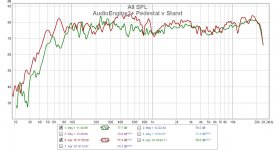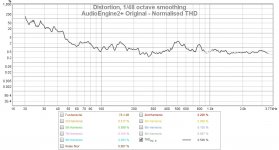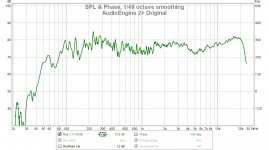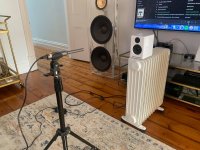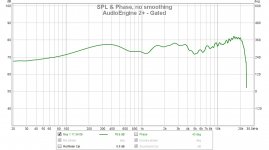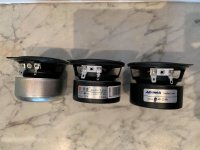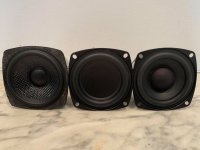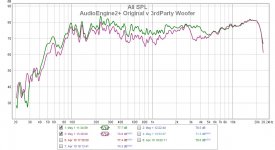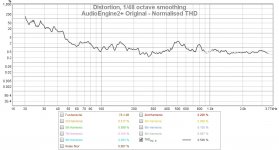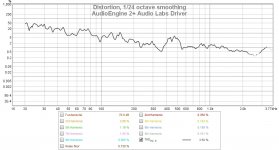I have recently purchased a pair of Audioengine's tiny 2+ active speakers, to use in the bedroom for casual listening using my iPhone, and for noise to promote sleep (I love Rain and Storm noises).
A2+ Home Music System w/ Bluetooth aptX — Audioengine
For WHAT they are, and for my intended purpose I'm quite impressed. No they don't play deep, and yes the boosted bass sounds a bit bloated (i'm using on bedside table, so I assume getting extra boundary reinforcement), but overall they are listenable, fun, and very unobtrusive visually.
While I'm impressed, naturally, the back was popped off within hours of owning them!
I can immediately think of a few ideas that might improve them a little, and could make for fun little project.
- driver transplant - if i can find something better that fits without significant physical rework.
- further port/boost tuning to tame response
- cross-over measurement and potential improvement, even if just cap quality.
- perhaps, removal of audio limiter? (NJM2761)
- transplant of TDA7292 to replace 7265, and review of implementation
- general bypass/decoupling improvements
- optimised PSU (default is a switching external pack, but has a pair of 2200uF internally)
I appreciate that being an integrated low cost device, spending much on these is overcapitalising them, but I cant help but want to try see what can be achieved without butchering them or changing the DNA too much!
Curious if anyone here has a pair of Audioengine 2+ and done any mods?
A2+ Home Music System w/ Bluetooth aptX — Audioengine
For WHAT they are, and for my intended purpose I'm quite impressed. No they don't play deep, and yes the boosted bass sounds a bit bloated (i'm using on bedside table, so I assume getting extra boundary reinforcement), but overall they are listenable, fun, and very unobtrusive visually.
While I'm impressed, naturally, the back was popped off within hours of owning them!
I can immediately think of a few ideas that might improve them a little, and could make for fun little project.
- driver transplant - if i can find something better that fits without significant physical rework.
- further port/boost tuning to tame response
- cross-over measurement and potential improvement, even if just cap quality.
- perhaps, removal of audio limiter? (NJM2761)
- transplant of TDA7292 to replace 7265, and review of implementation
- general bypass/decoupling improvements
- optimised PSU (default is a switching external pack, but has a pair of 2200uF internally)
I appreciate that being an integrated low cost device, spending much on these is overcapitalising them, but I cant help but want to try see what can be achieved without butchering them or changing the DNA too much!
Curious if anyone here has a pair of Audioengine 2+ and done any mods?
Last edited:
Today measured with REW and UMIK-1 with Audioengine 2+ plugged into laptop via USB.
Measured Left Channel (with active components) only, in situ sitting on bedside pedestal with UMIK-mic 0.5m away, on axis with tweeter.
Used single sweep, with length 512K. All graphs smoothed at 1/48.
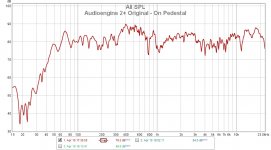
Distortion
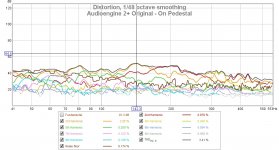
Re-measured - disconnecting each driver in turn.
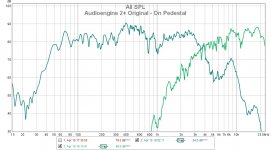
At this modest volume I believe the THD over 3.4% at ~142Hz is considered fairly high.
I would welcome opinions and what I should be looking for or measuring.
Measured Left Channel (with active components) only, in situ sitting on bedside pedestal with UMIK-mic 0.5m away, on axis with tweeter.
Used single sweep, with length 512K. All graphs smoothed at 1/48.

Distortion

Re-measured - disconnecting each driver in turn.

At this modest volume I believe the THD over 3.4% at ~142Hz is considered fairly high.
I would welcome opinions and what I should be looking for or measuring.
I'd look at reducing the raised area around 500Hz, either with a notch filter in the crossover or EQ, and would probably call it good at that.
There's also a dip in the upper midrange area, which might be crossover-related. Changing the height of the mic might alter things, though, as there'll be some lobing between the drivers.
Chris
There's also a dip in the upper midrange area, which might be crossover-related. Changing the height of the mic might alter things, though, as there'll be some lobing between the drivers.
Chris
If you ***really*** want to know where there are problems, you need to perform a gated measure. Most dips/bumps can easily be related to reflections.
For sure the woofer breakup seems severe enough to be tamed.
Ralf
For sure the woofer breakup seems severe enough to be tamed.
Ralf
In addition to remarks already made: that distortion plot looks fishy: any 6/5/4" or so woofer has a rising profile south of 100 Hz, even at low signal levels.
Many thanks for the replies and suggestions to look into - very much appreciated.
In the first instance I decided that Id measure in a different location - the bedroom location has hard wardrobe door very nearby. I decided to measure in my lounge - a slightly bigger room, with surfaces further away, and also thought id try it on a crude stand (a portable heater!) to see how much the bass is being augmented by sitting on top of the flat bedside table surface.
This totally removes the ~500Hz hump. The dip in the upper mid-range ~5K is still there. Next I might check the cross over and see if any changes can help.
The bass clearly receives huge benefit sub 100Hz sitting on the bedside table flat surface.
Thanks, I did a little reading and applied normalisation. Is this more what you'd expect to see?
I'd look at reducing the raised area around 500Hz, either with a notch filter in the crossover or EQ, and would probably call it good at that.
There's also a dip in the upper midrange area, which might be crossover-related. Changing the height of the mic might alter things, though, as there'll be some lobing between the drivers.
Chris
If you ***really*** want to know where there are problems, you need to perform a gated measure. Most dips/bumps can easily be related to reflections.
For sure the woofer breakup seems severe enough to be tamed.
Ralf
In the first instance I decided that Id measure in a different location - the bedroom location has hard wardrobe door very nearby. I decided to measure in my lounge - a slightly bigger room, with surfaces further away, and also thought id try it on a crude stand (a portable heater!) to see how much the bass is being augmented by sitting on top of the flat bedside table surface.
This totally removes the ~500Hz hump. The dip in the upper mid-range ~5K is still there. Next I might check the cross over and see if any changes can help.
The bass clearly receives huge benefit sub 100Hz sitting on the bedside table flat surface.
In addition to remarks already made: that distortion plot looks fishy: any 6/5/4" or so woofer has a rising profile south of 100 Hz, even at low signal levels.
Thanks, I did a little reading and applied normalisation. Is this more what you'd expect to see?
Attachments
Last edited:
If you ***really*** want to know where there are problems, you need to perform a gated measure. Most dips/bumps can easily be related to reflections.
For sure the woofer breakup seems severe enough to be tamed.
Ralf
Cheers! While I moved to a less reflective location and setup for these measurements, I did try gating to learn - I've not done it before so I hope I did it right!?
There didn't seem to much obvious on the Impulse plots other than the ripples around 3.25ms, I assume at the low output level used, and less reflective room, there weren't significant reflections. I tried gating at 2.5ms.
Attachments
I also decided to swap in some low cost 3" woofers purchased from Ebay and AliExpress. These were selected based on
These were swapped and remeasured.The two alternative drivers had indistinguishable frequency response plots from each other, and both a little worse than the original, lower sensitivity, with peaks and dips in the mid-range.
The distortion however shows much bigger differences! The two alternative drivers have significantly worse distortion!
While I didn't expect the differences to be so great I really must commend the little factory driver in this comparison.
- Having the exact same frame size as the original
- Having the lowest claimed Fs, and being marketed for bass.
- Left(silver magnet) = Original
- Middle = Audio Labs. Purchased from Ebay, described as; "3" inch 4Ohm 4Ω 25W HI-FI Bass Audio Speaker Stereo Woofer Loudspeaker
- Right = Aiyima. Purchased from AliExpress, described as; Subwoofer 3" Inch 25W HiFi Subwoofer Speaker 4 8 Ohm Woofer Audio Sound Speakers Bass Loudspeaker Square DIY
These were swapped and remeasured.The two alternative drivers had indistinguishable frequency response plots from each other, and both a little worse than the original, lower sensitivity, with peaks and dips in the mid-range.
The distortion however shows much bigger differences! The two alternative drivers have significantly worse distortion!
While I didn't expect the differences to be so great I really must commend the little factory driver in this comparison.
Attachments
Last edited:
- Home
- Loudspeakers
- Multi-Way
- Audioengine 2+ Tiny Active Speaker Mods
